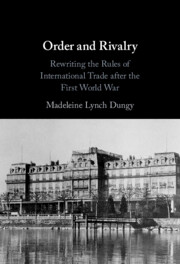Book contents
- Order and Rivalry
- Order and Rivalry
- Copyright page
- Dedication
- Contents
- Acknowledgements
- Organizational Abbreviations
- Introduction
- 1 Organizing Globalization
- 2 The World Economy at War
- 3 Planning the Peace
- 4 From Bilateral to Multilateral Trade Treaties
- 5 Studying the World Economy, from Kiel and from Geneva
- 6 European Unity and Security
- 7 The International Chamber of Commerce and the Politics of Business
- Conclusion
- Bibliography
- Index
Conclusion
Published online by Cambridge University Press: 01 June 2023
- Order and Rivalry
- Order and Rivalry
- Copyright page
- Dedication
- Contents
- Acknowledgements
- Organizational Abbreviations
- Introduction
- 1 Organizing Globalization
- 2 The World Economy at War
- 3 Planning the Peace
- 4 From Bilateral to Multilateral Trade Treaties
- 5 Studying the World Economy, from Kiel and from Geneva
- 6 European Unity and Security
- 7 The International Chamber of Commerce and the Politics of Business
- Conclusion
- Bibliography
- Index
Summary
In the long history of international trade politics, the League era was a complex period of transformation. Export growth slowed in the 1920s, especially in Europe, but this was not a straightforward rollback of pre-war globalization. Many functional relations of trans-border economic interdependence remained and many intellectuals, business leaders, and public officials were deeply committed to expanding those linkages even as they embraced more assertive national, regional, and imperial programmes. League collaborators used convergent multilateral methods to pursue sharply divergent visions of international order. Much of their conflict stemmed from the inconclusive 1919 Peace Settlement, which left openings for competing institutional programmes to develop. The regulation of foreign trade became a central platform for world-ordering impulses, but no single individual or government was strong enough to impose a unified vision of the world economy on the League. Llewellyn Smith arguably came closest during his brief period of dominance in the early Economic Committee.
- Type
- Chapter
- Information
- Order and RivalryRewriting the Rules of International Trade after the First World War, pp. 259 - 283Publisher: Cambridge University PressPrint publication year: 2023



